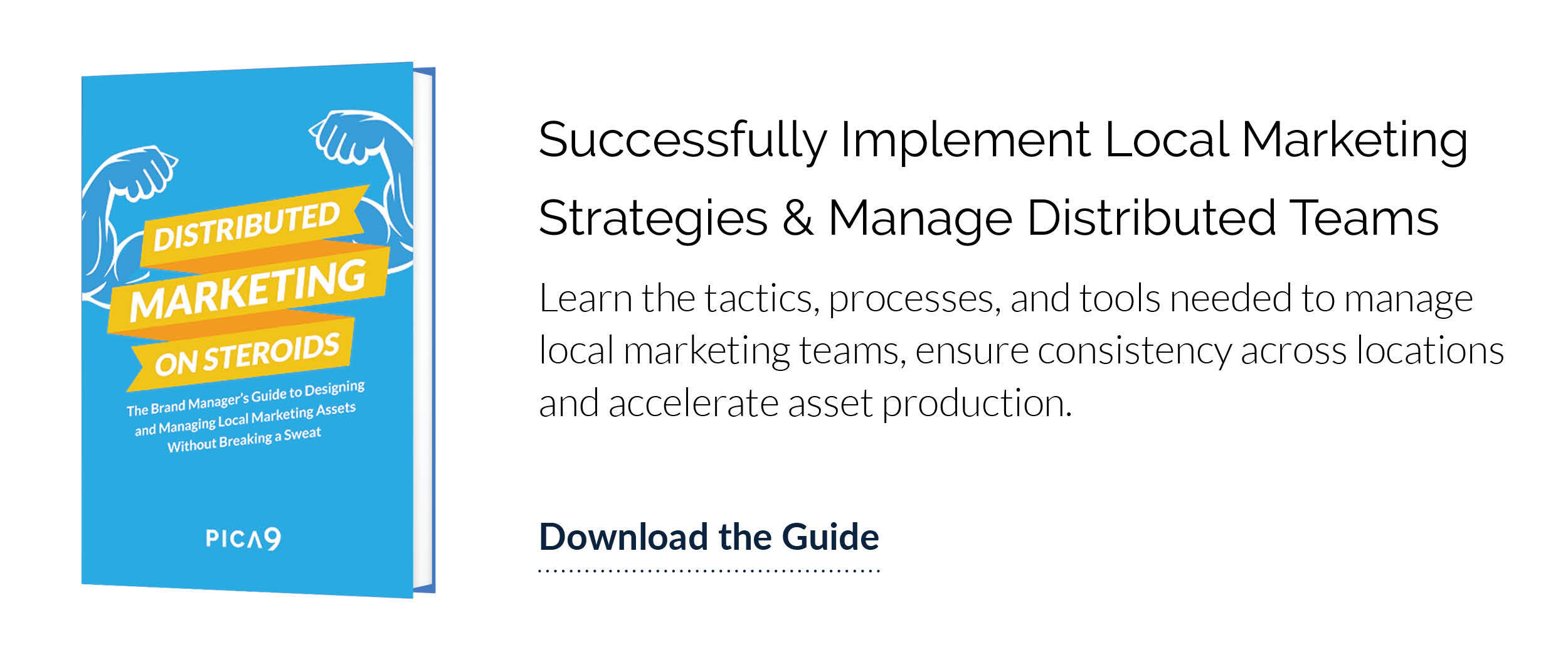For multi-location brands, building and maintaining a consistent customer experience is key. When you successfully deliver the same great experience from location to location, you nurture positive relationships with your customers and build up brand equity for the future. However, creating a consistent and memorable encounter with the customer is easier said than done.
Unfortunately, there's no one-size-fits-all solution for building great customer experiences across all your locations. But corporate marketing teams can identify local affiliates' pain points and give them directional advice about how to maximize local marketing effectiveness. With the right strategies and tools in place, corporate teams can help their local affiliates create more impactful local marketing that also leads to better customer experiences. To further bolster local affiliates' marketing, many industry-leading brands also choose to invest in software like Local Marketing Automation (LMA) that's dedicated to that purpose.
Are your own affiliates struggling to deliver high-impact local marketing? Corporate teams should identify, avoid and fix the following local marketing mistakes to keep those local efforts from falling flat.
Top 5 Reasons Your Local Affiliates' Marketing is Broken
Their Ads Feel Forced
Century 3 Kia located in West Mifflin, Pennsylvania introduced a series of video ads featuring known television and move personality, Gary Busey. In one advertisement, Busey is seen grilling steak in celebration of the dealership's all-new Labor Day sale. In another, Busey encourages viewers to visit the dealership for a free t-shirt. Busey is certainly entertaining to watch, however, these advertisements don't really honor the brand's commitment to quality, honest and trustworthy automotive sales. More than anything, the advertisements feel a bit like an over-the-top marketing stunt. Consumers pick up on that which makes them feel like the local dealership might be trying a bit too hard to get them to pull out their wallets.
To avoid making the same mistake, corporate marketing teams should reorient themselves and their local affiliates around the brand promise and values. Kia is known as a leader in automotive sales and purchasing. However, these wacky advertisements could be seen as contradicting the brand's core principals. Plus, they won't usually pan out in terms of on-the-ground results because consumers have become so attuned at filtering out marketing messages that feel hackneyed or overblown.
Ready to create more authentic and high-impact local marketing? For more, check out How Enterprise Brands Execute Effective Local Marketing.
Their Marketing Doesn't "Feel" Like the Brand
Customers crave authenticity and consistency from the brands they love. When local affiliates stray from the parent brand's primary messaging and create marketing that doesn't "feel" like the brand, customers will be more likely to jump ship. For example, T.G.I. Fridays attempted to redefine their brand image to attract millennial audiences. A franchise location in Manchester, England even painted a branded mural in the trendy North Quarter. For most residents and consumers, this local marketing stunt felt a bit out of place and ironic coming from a brand like TGIF.
When brands haven't properly prepared their field for "mixing things up" they're setting the franchisees up for failure. Without clearly defined rules in place, local affiliates may try to take their marketing up a notch, but do so in a way that's not quite what the HQ team would want. Oftentimes, these rouge marketers create ads that don't tie into the brand's core mission and values. For consumers, the unexpected approach could even be enough to turn them off to a brand they've loved for years. To avoid the risk of off-brand marketing, corporate teams can prepare franchisees for changes in the brand strategy by giving them all the newly pre-approved marketing materials that go with the new approach and telling them exactly how they should (and shouldn't, if need be) be used.
Franchise Corporate Teams Haven't Vetted the Latest Marketing Fad
Recently, memes have become a popular marketing tactic. But without the right strategy in place, these memes can take a turn for the worse when they're used for marketing purposes. In 2016, Gold's Gym landed themselves in hot water when an Egyptian franchisee created a social media post that insulted women. The image showed a green pear and said: "this is no shape for a girl." The brand quickly apologized, removed the post from social media and even decided to terminate the franchise agreement with that location.
Without properly vetting the latest and greatest marketing trend at HQ, brands could end up in the same spot. Given how easy it easy to make all kinds of memes and gifs these days, corporate marketing teams need to stay on top of their local affiliate's activity and be prepared for smart marketing trends that local affiliates might want to jump on. If the trend doesn't align with the brand's core mission and values, the brand shouldn't try to force it and should let all the field marketers know that it's decidedly out of scope. The right trend is both timely and also represents (instead of conflicts with) the brand's distinct promises.
Their Local Market Landscape has Changed
According to Business Insider, Subway closed more than 900 stores in the U.S. in 2017. For a brand with as strong a consumer appeal as the famous sandwich chain, this might look like a big concern. But it's actually part of their concerted efforts to make sure their restaurants are in the best position possible. Reportedly, Subway is working to "realign markets to ensure the right Subway restaurants are in the right locations." Additionally, the brand is rolling out all-new remodels, new products and refining their operations. Despite these efforts, Subway executives know they need to invest in continued innovation due to the rise of popular "fast-casual" restaurants like Chipotle, Panera, and QDOBA across local markets.
In this instance, without the directional insight provided by the parent brand, Subway franchisees simply don't have the resources to stay competitive in a constantly shifting market. Each local store is unique and has its own share of regulars, passers-by, and potential customers. But when those things start to change on a franchisee it can be difficult for them to adjust in kind. To stay ahead, corporate marketing teams should keep in continuous communication with their local affiliates about local area trends that could affect their business. Brand marketers can then equip the franchisees with all-new messages, promotions, strategies, and tactics that will appeal to this new breed of customers. With the right marketing strategy in place and well-equipped local affiliates, Subway looks like they're in a good position to be able to adapt across their whole network.
Their In-Store Experiences Feel Stale
Recently, KFC has been on a mission to refresh their franchise locations. In fact, 70 percent of KFC locations have already seen massive updates to their in-store signage, menus, store layout and much more. The store re-design is intended to modernize the chain's appearance with a "cleaner and bolder look." Additionally, these design updates take advantage of a revamped marketing strategy that includes wacky pop culture references.
Unlike "the Colonel," many brands struggle to keep their in-store experiences fresh across all locations over time. Providing a fresh coat of paint, a snazzy rearrange of the store or even just a new sign in the window is like a beacon to customers that says "COME OVER HERE." If your local affiliates aren't updating their properties frequently enough, customers start to feel it each time they walk by. To avoid making the same local marketing mistake, corporate marketing teams should keep their local affiliates supplied with new in-store signage, displays, table toppers, and more that they can use to refresh their stores every few weeks. These items are designed to enhance the look and feel of each franchise location and really raise the customer's perception of the brand. Consider partnering with your field auditing team to identify where the in-store experience is currently falling flat and use that feedback to guide how you create new assets.
Learn how to create more impactful in-store displays in 3 Marketing Collateral Management Tips from Top Brand Managers.
Boost Local Franchise Marketing Results With LMA
In 2018, the local marketing landscape will be more competitive than ever before. When local marketing falls flat, corporate teams risk a chain reaction of problems that hurt the customer experience. With today's consumers, any customer experience issues can be magnified and compounded as customers detach themselves from brands they think are inauthentic or behind-the-times. To maximize local marketing effectiveness, top brands have started using all-new marketing strategies and solutions. Local Marketing Automation tools and other dedicated local marketing software are a huge part of this trend. Corporate teams are also more aware than ever about the importance of local marketing and they're taking proactive measures to stay ahead of any issues that might make their local affiliates' marketing fall flat. Now you can too!
Is your brand equipped to take on the latest marketing challenges? We recently surveyed industry-leading distributed brands for their perspective on the state of the distributed marketing landscape. Use their insight to guide your local marketing efforts and hurdle the biggest local marketing roadblocks in your path.
Discover the latest distributed marketing trends in the 2017 Distributed Marketing Benchmark Report.







